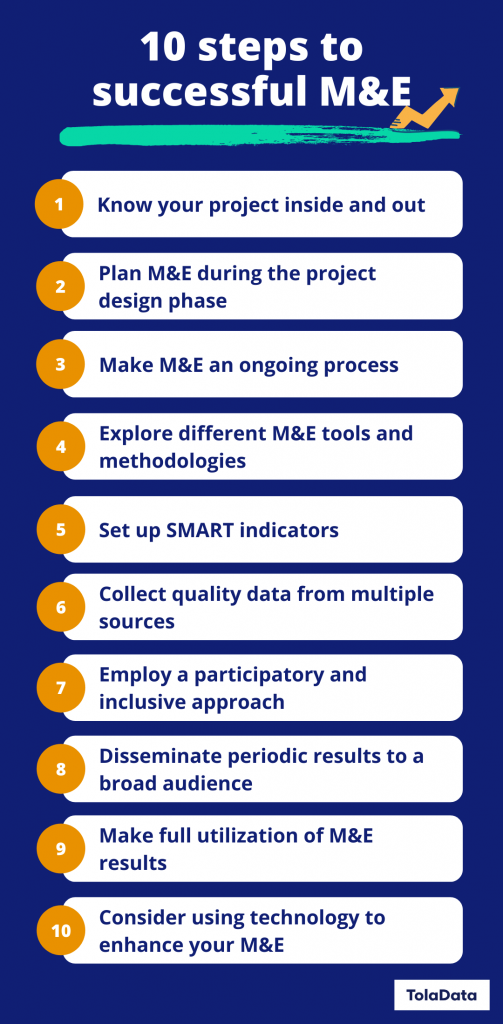10 steps to successful M&E
April 25, 2019
Figuring out how and when to design a Monitoring and Evaluation (M&E) plan could be quite tricky, we agree! But with the right approach, and some helpful tips and tricks from the experts, you could have a lot of fun and success in planning and implementing M&E into your projects.
So, if you are someone working in the non-profit sector, including NGOs, INGOs, Foundations or Social Enterprises, our top ten tips from the in-house experts could be beneficial. Learn about a favorable time to incorporate M&E into your project, how to choose the right M&E tools and methodologies, the crucial role of indicators and more!
1. Know your project inside and out
Before you begin to map out your M&E plan, it is essential to acquire a thorough understanding of your project. Here are some good questions to ask – What are your project goals and objectives? What problem is the project trying to solve? What steps will be taken to solve those problems? Has your target audience been defined? What is your available budget and resources? What is the intended time-frame of your project? And how do you plan on measuring your interventions? Answering these questions could help you build the groundwork of M&E.
2. Start planning M&E during project design phase
As you plan your project objectives, logistics and resources, it is best to start designing and incorporating your M&E simultaneously with input and feedback from all stakeholders and team members involved in the project. It is important to link your M&E plan to the project’s strategic plan in an integral manner. This ensures effective allocation of resources, establishment of roles and responsibilities, an understanding of the political and administrative structures of the community where the project will take place etc. Likewise, planning M&E early on also helps to identify your baseline values to measure the success and failure of the interventions during project implementation and your impact at completion.
3. Make M&E an ongoing process
In the traditional development realm, M&E was implemented only during the final stage of the project cycle – this is an ineffective and archaic practice. M&E is a fundamental part of a project and it must be incorporated in parallel to your project interventions. This allows you to see a full picture of your project’s history, its scope and complexities to uncover anomalies, respond to issues as they arise, predict likely scenarios, improve internal coordination, optimise resource allocation, prescribe beneficial potential actions and make informed decisions.
4. Explore different M&E tools and methodologies
M&E has many tools, frameworks, methodologies and approaches for different stages and activities of a project. The key to successful M&E is to choose and triangulate the ones that best fit the scope of your project. Asking these questions might help to determine your relevant options – what type of project is to be monitored and evaluated, and at what stage? Where and how do you intend to use the tools and methods? Is qualitative method more suited than quantitative for your interventions? (Quantitative methods track changes in ‘quantifiables’, while qualitative methods reveal perspectives, perceptions or behaviours.) Can you logically and strategically articulate the reasoning behind your choice? And what capacity, resources and expertise are available to utilise the particular tool or method? More on Qualitative and Quantitative data collection methods in M&E.
5. Set up relevant indicators
Indicators are called the backbone of M&E for all the right reasons. Indicators are specific and concrete pieces of information that enable you to collect the right set of data to track the changes you are trying to achieve through your project, program or strategies. Every level of your project, whether be it an output, outcome or impact should have its own set of indicators to measure your performance and interventions.
But it’s important to make sure that the indicators you choose are specific, relevant, timely, achievable, have a baseline, a unit of measure, a target and are easily disaggregable. The rule is always quality vs. quantity. The tendency to define too many indicators, or those without accessible data sources could make the system costly, impractical, and likely to be underutilized. Here’s how to create indicators that make sense.
6. Collect quality data from multiple sources
Data is one of the most powerful elements in M&E. Both qualitative and quantitative data articulate the behaviors and circumstances behind those numerical and categorical data. When compared against the project indicators, data provide clear evidence of the real performance of the project, thus allowing the project team to make decisions grounded in reality and facts, instead of assumptions.
Whether using existing data or collecting your own, gathering clear, useful and relevant data from multiple sources helps to gauge progress at various levels of the project in a more expansive manner, while diversifying the impact of M&E and making it more comprehensive and efficient. But just like indicators, the trick here is also choosing quality over quantity, only collecting and using what you need – irrelevant data can cost you time, resources and a lot of headache. Check how TolaData can help bring data from multiple sources under one roof.
7. Employ a participatory and inclusive approach
A participatory and inclusive approach to M&E increases the sense of ownership and motivation amongst all team members, field staff, beneficiaries, stakeholders, donors and other parties associated with the project. This ensures that every member involved has an opportunity to voice their opinions and provide input on assessing the situation, shaping project design/plans and identifying the desired results and participating in decision-making around the direction of the project as active participants rather than passive recipients. This helps build local capacity and ownership to manage and sustain the project and develop collaboration and consensus at different levels.
Here’s how you can sustain a participatory M&E approach even during a pandemic, such as COVID19, when most processes have shifted to remote practices.
8. Disseminate periodic results to a broad audience
In traditional M&E, reporting was usually done annually or towards the closing of the project and mostly only to the senior management team and donors but this is no longer a recommended practice. Reporting should be periodic and multidirectional.
As much as it’s important to keep senior management and donors up to date, it’s equally important to share timely and relevant project information to field staff, partners and the beneficiaries themselves. This helps everyone involved in the project to grasp and learn from the successes and failures as they come and suggest necessary improvements and adjustments to the project. This also helps the organisation to ensure full transparency and accountability on its part. There are many digital solutions available to help you and your organisation with your real-time reporting needs – see how TolaData can help!
9. Make full utilization of M&E results
M&E data is only useful if it’s analysed and put to good use. Results data can inform ongoing project decision-making and strategic planning for future projects and interventions, contributing to overall organizational learning and knowledge-sharing. M&E results data can also foster major changes in the way organisations, governments and other institutions operate, leading to improved performance, accountability and transparency. Such data can also be leveraged to advocate for changes in policies and to contribute to the global understanding of what works.
10. Consider using technology to enhance your M&E
As demands for greater transparency, real-time data collection, instant feedback, quantifiable results and remote monitoring have increased, the role of ‘Information and Communications Technologies (ICT)’ has gained momentum in M&E. With so many cutting edge technological tools and software available in the market, it’s time to move away from paper-based M&E and adopt digital alternatives that can help you save time and resources, improve your efficiency, avoid human errors and increase the value and impact of your project.
Explore intuitive tools to collect real-time data with ease from multiple online or offline sources, reach a larger audience through digital reporting tools, compare your actuals vs. targets with indicator management tools and more. The technological possibilities for M&E are simply limitless.
Here’s a quick summary of the 10 steps to successful M&E.

We really hope these tips were helpful. Please let us know if you have anything to add to the list. We look forward to keeping this conversation going!
By Chandani Lopez Peralta, Content Marketing Manager at TolaData.



Very interesting. The subject is well summarized and allows to learn best practices in monitoring and evaluation. Your site is a real training tool for the monitoring and evaluation profession.
Very good article. I wish to add another important elements ” 1) M&E staffing” is key for the success of M&E system. It is better to have experienced staff who have multidimensional skills who will lead the M&E processes within organizations
2) Budget: It is better to have M&E budget at least 10% of overall project budget. In many cases, organizations do not set aside M&E budget and or allocate insignificant amount
Thank you for your comment, Celestin Nsengiyumva. We completely agree with your points – staffing and budget are definitely crucial for the success of any M&E system. We have included those points, plus more in our recent article “M&E Plan for NGOs.”
https://www.toladata.com/blog/monitoring-and-evaluation-plan/
This is very informative and powerfully. The important aspect you add in the CLA. How do the project team or stakeholders use CLA approach for successful programming? How do teams come up with learning and evaluation questions? And they can integrate CLA and learning questions in their work plans and reflection sessions?
Thank you for supporting our work, Acamango Vicky. We look forward to exploring and adapting the “Collaborating, Learning, and Adapting (CLA)” practices into our upcoming articles to help our readers/users improve their development effectiveness.
Can these steps of monitoring and evaluation system also apply in Education
Absolutely, Hilda!
Wow!!! Thank you Celestin
My concern is , can we talk about M&E ni government organizations?! I wish to get contribution for any one with experience. Thank you
These are very important points.
One important part of a successful M&E process is also if we can learn from it. If it can inform evidence-based decisionmaking. So that we shift M&E from being data-centric to learning-centric.
Absolutely agree with your point, Walter! We have added a new point to the list as per your recommendation – “making full utilization of M&E results.”
I like the ten steps offered by Toladata for setting up M&E Plans for an organisation. Let me add that to point number 7, that the M&E staff should share information and roles with their team; especially with the limitations now caused by the pandemic. I find that traveling to branch offices has to become limited and yet team members may not know which data to collect and post to support the M&E function. Therefore M&E officials need communication, interpersonal and training g skills or attributes to help them build a good working relationship. However, the top management should be supportive to this team approach.
The topic is excellent. Please share any good example of an M&E framework and M&E Systems (web-based platform) for SDG 2 for multi-agency and multi-projects, as a reference for teaching and research. Thank you.